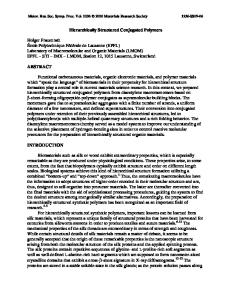Subgap Absorption in Conjugated Polymers
- PDF / 366,337 Bytes
- 6 Pages / 420.48 x 639 pts Page_size
- 63 Downloads / 395 Views
SUBGAP ABSORPTION IN CONJUGATED POLYMERS M. Sinclair*, C. H. Seager*, D. McBranch**, A.J. Heeger** and G.L. Baker*** *Sandia National Laboratories, Albuquerque, NM "**University of California, Santa Barbara, CA ***Bell Communications Research, Red Bank, NJ ABSTRACT Along with X(3), the magnitude of the optical absorption in the transparent window below the principal absorption edge is an important parameter which will ultimately determine the utility of conjugated polymers in active integrated optical devices. With an absorptance sensitivity of < 10-5, Photothermal Deflection Spectroscopy (PDS) is ideal for determining the absorption coefficients of thin films of "transparent" materials. We have used PDS to measure the optical absorption spectra of the conjugated polymers poly[1,4-phenylenevinylene] (and derivitives) and polydiacetylene-4BCMU in the spectral region from 0.55 eV to 3 eV. Our spectra show that the shape of the absorption edge varies considerably from polymer to polymer, with polydiacetylene-4BCMU having the steepest absorption edge. The minimum absorption coefficients measured varied somewhat with sample age and quality, but were typically in the range 1 cm- 1 to 10 cm- 1 . In the region below 1 eV, overtones of C-H stretching modes were observed, indicating that further improvements in transparency in this spectral region might be achieved via deuteration or fluorination. INTRODUCTION One of the principal challenges associated with the advancement of integrated optics is the development of nonlinear optical materials for use in active elements. Conjugated polymers, because of their large nonlinear optical susceptibilities, have been recognized as a class of materials possessing great potential for use in these applications [1]. However, in contrast to the large amount of research that has been done on their nonlinear optical properties, the important subject of optical losses has received relatively little attention [2,3]. In order to fully evaluate conjugated polymers for guided wave applications, it is essential that the mechanisms of optical absorption be understood. Attenuation of a guided optical wave can arise from a number of intrinsic and extrinsic sources, and can have detrimental effects on the performance of a device element. Onephoton absorption arising from overtones of lattice modes and the low energy tail of the principal electronic absorption edge; as well as two-photon absorption [4], are examples of intrinsic loss mechanisms. Extrinsic loss mechanisms include scattering from material inhomogeneities and dimensional nonuniformities of the waveguide; and absorption losses due to impurities. While extrinsic loss mechanisms can, in principle, be eliminated through improved material processing, intrinsic losses can only be reduced by altering the nature of the material (at the risk of decreasing the magnitude of the optical nonlinearities). When significant losses are present, the distance over which a useful amount of light may be propagated is limited. Thus, the number of active optic
Data Loading...











